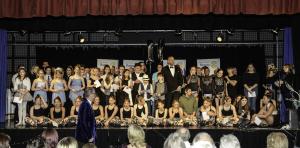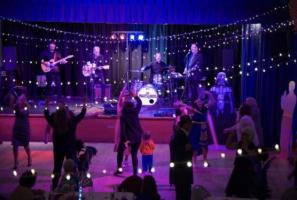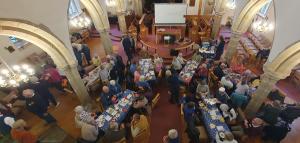Trains, Trams and Trolley Buses - Stephen Wright
Thu, Nov 2nd 2023 at 7:00 pm - 9:00 pm
Steve gives us the introduction to public transport in the East Midlands
Club members please log in for more information.
2nd November 2023 Trains, Trams and Trolley buses – Steve Wright
Before Steve began his presentation Gerry announced that the initiative with the Co-op had produced a donation of about £1300 towards some equipment for the Memory café. Chris B then did grace in Latin, as they used to do at Oxford, dedicating it to his old University friend Joseph Prescott, who had recently passed.
Steve did a mining Engineering Degree at Trent Polytechnic, spending his career with the NCB, rising to a management role, with his interest in trains coming from his parents and grandparents. So, an introduction to public transport followed with lots of illustration and pictures. He informed us that photography was not available when it all started in the mid-19th century. His suggestion was that it all began in the Sun Inn in Eastwood, in 1832, with the meeting of a number of men who owned mines who wanted a railway to get the coal to market, in Derby, Nottingham and Leicester, rather than the slow canal system in existence.
The first train ran on May 3rd 1839, carrying 600 people from Derby to Nottingham in 30 minutes, under the banner of “Midland Counties Line”, quickly recognising the attraction of transporting people as well as coal. 1848 saw the new Midland Station, eventually extending the line to Newark and Lincoln. Then 1900 saw the second Midland station, followed by the 3rd in January 1904. Then the “Great Northern Railway”, operating to London Road station took a line from Grantham. The Victoria station built in 1898, was en-route for the fast line from Sheffield to London St. Pancras, until the last train emerged on 2nd September in 1967. It was the 50’s and 60’s that was the “hay day” of the rail industry.
An Earlier development was Horse buses, a progression from stage coaches, followed by The Nottingham and District Tram Company in 1875, when Trent Bridge was the horse drawn Tram terminus. Obviously, for some of the slopes around Nottingham city centre the horses required help, which was provided by extra horses (called cock horses). They then tried Steam Trams which proved too heavy for the road infrastructure, but 1897 saw Nottingham Corporation take over the operation and by 1903 there were 103 electric trams, going out to Bulwell and Colwick. 1927 saw the introduction of Trolley buses as the last tram operated in 1936, whilst the trolley buses continued to 1966.
Peter thanked Steve for his information packed historical presentation around the development of local public transport. It had reminded Peter of his young experience as a trolley bus conductor up in South Shields, where his rugby club colleagues insisted he didn’t charge them, to his embarrassment and consternation should the Inspector get on. He asked the members to join him in a round of applause to thank Steve. AR
'What We Do' Main Pages:

We have now successfully run this event for 10 years. Full reports of each year are available under this main page
more
It's here that you can read what we've been up to in the last few months. For more information on our work in the local community, with our young people and internationally please access "what we do" section of this web site.
more
This is a monthly meeting open to visitors from Bingham, Radcliffe, Cotgrave and all villages in surrounding area.
moreThis committee are involved in planning now we can raise funds for our chosen charities
moreIf you like what we do as an organisation and are interested in volunteering with us, keeping up to date with our plans and future events then why not consider signing up as a friend of our Rotary Club
moreOur International Committee is involved with Polio Plus - a Rotary initiative to eradicate Polio, World-wide; Sand dams; Aqua Boxes; Shelter Boxes; Collecting used spectacles, and many other projects
moreHere you can read about the many meetings we've had during our formation as a Rotary Club. The early years are a little short on detail...
more





